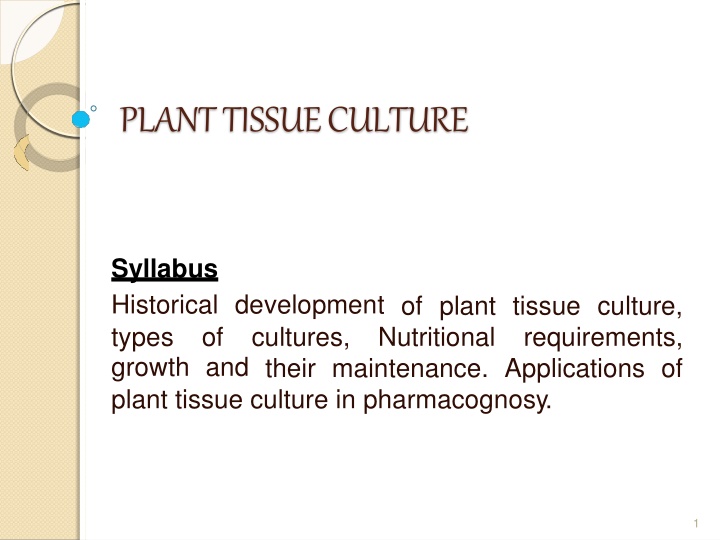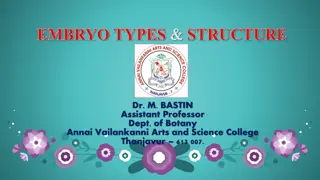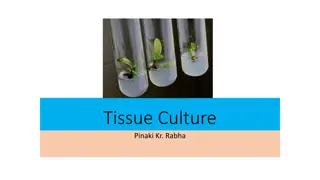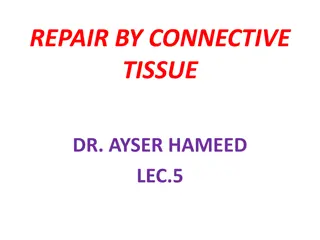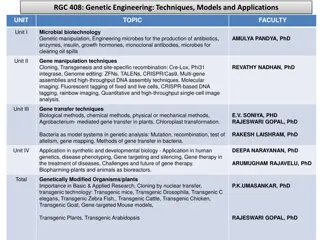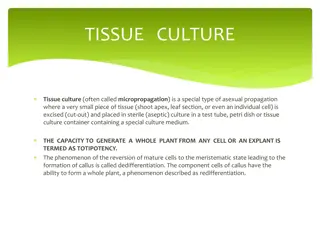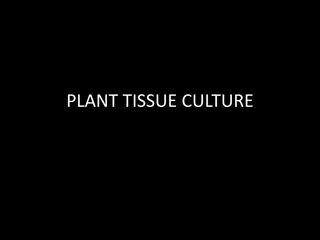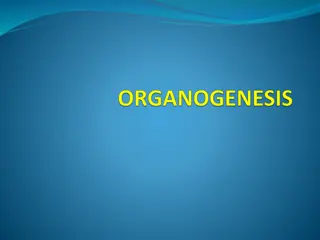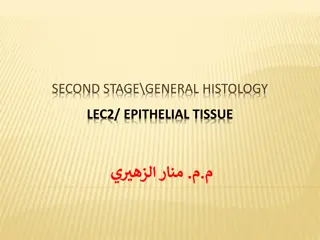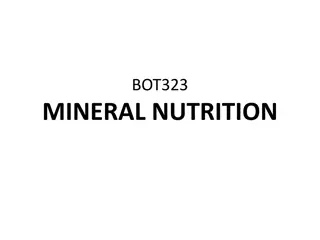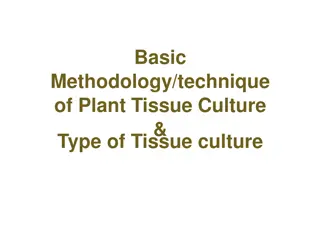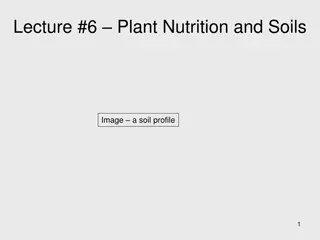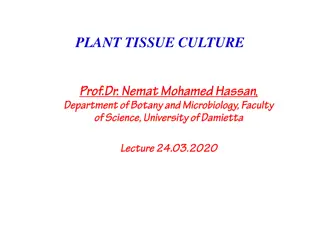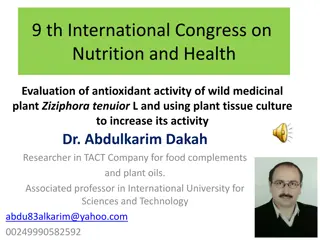Plant Tissue Culture: Historical Development, Techniques, and Applications
Plant tissue culture is an experimental technique that involves the in-vitro cultivation of plant cells to produce secondary metabolites, regenerate plants, and study organogenesis. This process allows for the maintenance of disease-free plant material, biosynthetic pathway tracing, and cell immobilization for biotransformation. Advantages include a stable supply of raw materials, quality control, and the potential for discovering new compounds through plant cell cultures.
Download Presentation

Please find below an Image/Link to download the presentation.
The content on the website is provided AS IS for your information and personal use only. It may not be sold, licensed, or shared on other websites without obtaining consent from the author.If you encounter any issues during the download, it is possible that the publisher has removed the file from their server.
You are allowed to download the files provided on this website for personal or commercial use, subject to the condition that they are used lawfully. All files are the property of their respective owners.
The content on the website is provided AS IS for your information and personal use only. It may not be sold, licensed, or shared on other websites without obtaining consent from the author.
E N D
Presentation Transcript
PLANTTISSUECULTURE Syllabus Historical development of plant tissue culture, types growth and their maintenance. Applications of plant tissue culture in pharmacognosy. of cultures, Nutritional requirements, 1
INTRODUCTION Tissue Culture Plant Animal Tissue Culture Tissue Culture Definition: Plant-tissue culture is in-vitro aseptic and semisolid well defined nutrient medium for the production of primary and secondary metabolites or to regenerate plant. In other words it is an experimentaltechnique through which a mass of cells (callus) is produced from an explant tissue. The callus produced through this process can be utilized directly to regenerate palntlets or to extract secondary metabolites. cultivation of plant cell or tissue under controlled environment conditions, in liquid or on or manipulate some primary and 2
The plant tissue culture refers to the cultivation of a plant cell which normally forms a multicellular tissue. When grown on agar medium, the tisse forms a callus or a mass of undifferentiated cells. The technique of cell culture is convinient for starting and maintaining cell lines, as well as, for studies pertaining to organogensis and meristem culture. The technique of in-vitro cultivation of plant cells or organs is primarily devoted to solve two basic problems: 1. To keep the plant cells or organs free from microbes 2. To ensure the desired development in cells and organs by providing condition. suitable nutrient media and other environmental 3
Advantages of tissue culture 1. Availability of raw material Some plants are difficult to cultivate and are also not available in abundance and tissue culture technique is considered a better source for regular and uniform supply medicinal plant industry phytopharmaceuticals. of raw material for production for of 2. Fluctuation in supplies and quality The method of production of crude drugs is variable in quality due to changes in climate, crop diseases and seasons. All these problems can be overcome by tissue culture. 3. New methods for isolation It is possible to obtain new methods for isolation and newer compounds from plant by this technique and for which rights can be obtained. Patent 4
4. Biotransformation (Process through which the functional group of organic compound are modified by living using plant-cell cultures. cells) reactions are feasible 6. Disease free and desired propagule Large scale production of plant with disease free and desired propagule could be stored and maintained transportation for subsequent plantation. without any damage during 7. Biosynthetic pathway Tissue culture can be used for tracing the biosynthetic pathways of secondary metabolites using labelled precursor in the culture medium. 8. Immobilization of cells Tissue culture can be used for plants preservation by immobilization (entrapment)of cell further biotransformation. facilitating transportation and 5
9 Continuous, uniform biomass is obtained. 10. Medicinally important compound can be synthesized, which can t be synthesized chemically. 11. Useful natural compounds can be produced, independent of soil condition & change in climatic conditions. 12. Improvement of medicinal plant species. 13. Propogation of plant without seeds in defined and controlled condition. 6
Disadvantages of tissue culture 1. 2. 3. High level of expertise is required. Asmall error may lead to complete collapse of product/plant. Lots of chemicals are required for plant tissue culture which must contain high purity. There is no chance for evaluation of mutation. Culture on artificial medium may lead to the depression of unusual metabolic pathways, which may not be beneficial to biotechnologist. In majority cases amount of secondary metabolites produced is negligible. The protocols for individual plants differ very widely and Change in the medium constitution & environmental parameters affect the rate of cell growth & accumulation of secondary metabolites. To maximize on the cell mass produced the cell suspension culture eventually becomes very dense and these presents problems of even aeration. Instability Slow growth Expensive process Aseptic conditions are to be maintained through out the growth of plant. 4. 5. 6. 7. 8. 9. 10. 11. 12. 7
Historical development of plant tissue culture The principles of tissue Schleiden and Schwann. culture were involved in cell theoryadvanced by 8
Basic requirements of Plant Tissue Plant material Equipments and Glasswares Aseptic Condition Washing and storage facilities Media preparation room Sterilization room Nutrient medium Transfer room Culture room or incubators Proper and optimum aeration Well equipped observation or recording area Culture: 11
Plant material The plant material should be disease free and should not be too old. Also the particular species/variety/genotype which are used should be the right one. Generally in-vitro germinated seedlings are frequently chosen as seed is often also much more readily sterilized than softer plant tissues. When plants are healthy and at the desired stage for use, it is often the case that only a specific part of these plants will give the best explants. E.g.Aparticular internode, the youngest fully expanded leaf etc. Equipments and Glasswares Incubating chamber or laminar airflow cabinet with UV light fitting for aseptic transfer Incubator with temperature control 0.5 C generally temperature recommended for most tissue culture studies is 36 C. Autoclave-for sterilization of glassware, media etc. Refrigerators and freezers-For storage of reagents, tissue culture stock solutions, chemicals etc. 12
Hot air oven-for dry sterilization of glassware, media etc. Microscope-Simple and special microscope with a provision to take camera are required. The stage of this microscope should be large enough to accommodate large roller bottles in specific cases. pH meter- for adjusting the pH of the medium A spirit burner or gas micro burner for flame sterilization of instruments Washing up equipments- Washing facilities for glassware, pipette etc. in deep soaking baths or washing sinks of stainless steel or polypropylene are suitable for manual washing and rinsing of almost all types of glassware except pipettes. Standard siphon type pipette washers are suitable for washing the pipettes soaked in detergent for overnight. The washed pipettes should be rinsed with deionised water and dried in a stainless steel pippette dryer. Water purifier- Pure water is required at most of the plant tissue culture study. Centrifuge- To increase the concentration of cell suspension culture 13
Shakers-To maintain cell suspensionculture Balance- To weigh various nutrients of the preparation of the medium Shelves- Build from rigid wire mesh to allow maximum air movement and minimum shading should be used in the culture room. Scissors, scalpels and forceps- For explant preparation from excies plant parts are for their transfer Culture vessels- Usually borosilicate glass vessels are preferred, it includes test tubes, conical flasks, bottles, special flat tubes etc. Now, the common vessels are 100 ml conical flasks or large test tubes of 25 150 mm size. Glasswares- Like measuring cylinders, beakers, funnels, petri dishes, graduated pipette, conical flask etc. Are required for preparation of nutrient media. Miscellaneous-Non absorbent cotton plug, screw cap or polyurethane foam is required to close the mouth of the culture vessel.Aluminium foil is required to cover the exposed part of plug from becoming wet when autoclaved. Labels, marking pencils, hand lens, plastic disposables like syringes, plastic bottles, hot plate, stirrer etc. Microwave- not essential but it melts the solidified media for pouring in culture vessels like petri dishes etc. 14
Aseptic Condition The plant materials (tissues), equipments, culture media and the room should be free from microorganisms. Usually dry heat, wet heat, ultrafiltration and chemicals are used for the sterilisation process. Surface sterilisation of plant materials such as seed, fruit, stem, leaf etc. by agents like 9-10% calcium hypochlorite for 5-30 minutes 2% sodium hypochlorite solution for 5-30 minutes. The materials need to be washed thoroughly in double-distilled water, after sterilising in these solutions. 10-12% of hydrogen peroxide solution for 5-15 minutes. 1-2% bromine water, for 2-10 minutes 1% solution of chlorine water, mercuric chloride, silver nitrate or antibiotics etc. can also be used. Absolute alcohol is used for hard tissues 15
Dry heat method is used for sterilisation of equipments in hot air oven. Sterilisation of equipment with chromic acid-sulphuric acid mixture, hydrochloric acid, nitric acid strong detergent solution, alcohol, incubator or autoclaves etc. are use for this purpose. Wet heat method is used for sterilisation of glassware, culture media in autoclave at 121 C and 15 lb pressure for 15 minutes. Ultrafiltration is used for sterilisation of liquid media which are unstable at high temperature. Antibiotics are added to medium to prevent the growth of the microorganisms e.g. Potassium benzyl penicillin, strptomycin sulphate, gentamycin etc. Chemicals like alcohol are used for sterilisation of working area and the instruments. Sterilisation of the environment is done by fumigation method, the inoculation chamber is generally laminar airflow cabinet is widely used these days. 16
Washing and storage facilities Fresh water supply and disposal of waste water facility should be available. Space for distillation unit for the supply of distilled and double distilled water and de-ionized water should be available. Working table, sink or wash basin for apparatus/equipment washing should be acid and alkali resistant. Sufficient space is required for placing hot air oven, washing machine, pipette washers etc. For storage of dried glassware separate dust proof cupboards or cabined should be provided. Media preparation room It should be spacious to accommodate lab ware, culture vessels, equipments, chemicals etc. The preparation well equipped with refrigerator, freezer etc. and stock solutions. room should also be for storage of media 17
Sterilization room In the tissue culture lab it is desirable to have separate sterilization room for sterilization of culture media, glassware, metallic equipments like scissors, scalp etc. Generally sterilisation is done in autoclave or hot air oven. Nutrient medium Media is composed of Inorganic nutrients which includes macronutrients like nitrogen, phosphorous, potassium, calcium etc. and micronutrients like boron, copper, iron, manganese, zinc etc. Organic nutrients includes Vitamins like Vitamin B1, B6, B3, B5etc. Amino acids like L-arginine, L-asparagine, L-cysteine HCL, L-glutamine etc, Carbon source like glucose or maltose, Growth hormones/regulators like auxin, cytokininsand gibberellins, ethylene,abscisic acid. Others media substances like protein hydrolysates, yeast extaracts, fruit (e.g. banana) extracts, coconut milk, solidifying agents like agar, alginate, gelatin etc., Iron source e.g.EDTA,Antibiotics. pH of the medium should be in a range of 5.6-6.0 before autoclaving the culture medium 18
Transfer room It is provided with the laminar flow hood where most of the work of culture initiation and subsequent sub culturing is performed. Culture re-plantation, transfer or re-initiation in a clean media, harvesting of ripe cultures is also performed in this area. Culture room or incubators Cultures are incubated on shelves or in incubators under specific condition of temperature, humidity, air circulation and light. Incubation chamber or area should have both light and temperature controlled devices managed for 24 hours period. Generally high output, cool, white fluorescent light is preferred for a photo-period duration (specified period for total darkness as well as for higher intenesity light) with a temperature range of 25 2 C (range 18-25 C). The rooms are required to be maintined at a relative humidity upto 70-75% (range of 20-90% controllable to 3%) and uniform forced air circulation. 19
Proper and optimum aeration Adequate aeration is required for cell to grow. Tissues which are cultured on semisolid media do not require any special method for aeration, but tissues which are grown in suspension cultures, require special devices for aeration. Aeration for submerged cultures can be provided by following methods: Placing the culture vessel with the liquid medium on an automatic shaker. The two ends of the filter paper are dipped in a medium and the middle horizontal portion on which the tissue is placed remains above the level of the medium this method is called as filter paper bridge method. Passing sterilised air through the medium and by stirring the medium. The culture vessels are closed with non-adsorbent cotton covered in cheese cloth. This process allows proper aeration but prevents the entry of microorganisms. 20
Well equipped observation or recording area At regular intervals growth and maintenance of the tissue culture in the incubators should be recorded. All observations should be done in aseptic environment. For microscopic examination separate dust free space shold be marked for microscopic work. 21
